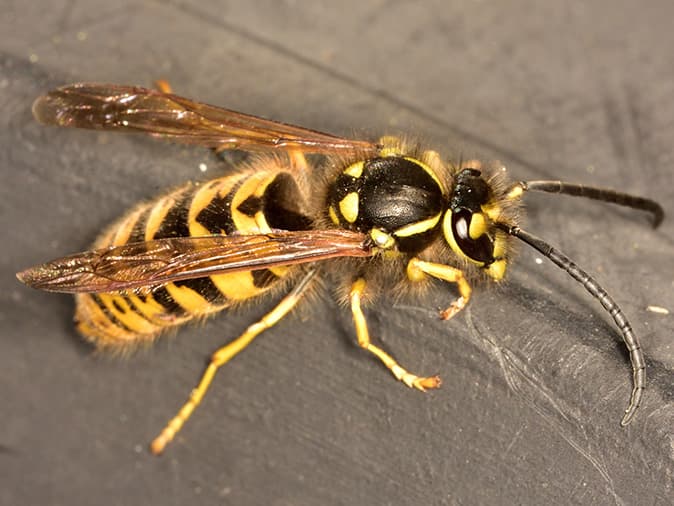Yellow jackets are small, stinging insects easily recognized by their bright yellow and black striped bodies. About half an inch long, these smooth and shiny insects have narrow waists and long wings that fold neatly when at rest. Known for their aggressive behavior, especially in late summer and early fall, yellow jackets can be a nuisance around homes—feeding on nectar, fruit, other insects, and often attracted to human foods and garbage. Understanding their appearance, habits, and nesting preferences is key to preventing and managing yellow jacket problems safely and effectively.

What do yellow jackets look like?
Yellow jackets are about half an inch long and have bright yellow and black striped bodies. These stinging insects are smooth and shiny, have narrow waists, and long, narrow wings that fold at rest.
What do yellow jackets eat?
Like many insects, yellow jackets are opportunistic feeders. They eat nectar, fruit, and other insects. Human food, especially sugary drinks, picnic foods, and garbage, also attracts them.
Where do yellow jackets build nests?
Yellow jackets build nests in a variety of locations, including:
- In the ground, often under lawns, patios, or decks
- In abandoned rodent burrows
- Wall voids
- Attics
- Under the eaves of buildings
Less commonly, yellow jackets may build nests in trees or shrubs, where the nests are usually hidden among dense branches or foliage.
Are yellow jackets aggressive?
Yes. Yellow jackets are more aggressive than many other stinging insects. Their aggression peaks in late summer and early fall when natural food sources run out, making them more likely to sting if they feel threatened or if their nest is disturbed.
Remember that disturbing a nest can trigger aggressive swarming, so it’s important to exercise caution and leave removal to professionals.
What happens if I get stung by a yellow jacket?
A yellow jacket sting is usually painful and may cause redness, swelling, and itching around the site. Most reactions are mild and subside within a few hours to a few days. However, anyone allergic to insect stings may experience a severe reaction called anaphylaxis, which requires immediate medical attention.
Can yellow jackets sting more than once?
Yes. Unlike bees, yellow jackets can sting multiple times because they do not lose their stinger.
When are yellow jackets most active?
Yellow jackets are daytime foragers, most noticeable during sunny hours around food, drinks, and trash. As noted above, late summer and early fall are peak times for activity and aggression, which is when homeowners often notice problems.
What are the signs of a yellow jacket problem?
Common signs of yellow jackets include:
- Frequent sightings near your home
- Nests
- Swarming around trash or outdoor food
Multiple stings or repeated encounters in a specific area are also a strong indication of nearby nests.
How do I eliminate yellow jackets?
Yellow jackets can be dangerous if disturbed, and DIY removal attempts often increase the risk of stings. That’s why contacting Pine State Pest Solutions at the first sign of an issue is the best solution. Our locally owned and operated pest control company has been helping Maine residents eliminate and prevent pests since 2011; you can count on our experience and expertise to solve your yellow jacket problem!
How can I prevent yellow jackets around my home?
To make your property less appealing to these yellow jackets and other stinging insects, we recommend the following prevention tips:
- Keep food and drinks covered when outdoors
- Cover garbage cans with tight-fitting lids
- Remove fallen fruit from your yard.
- Seal gaps in walls, eaves, and vents to reduce nesting spots
